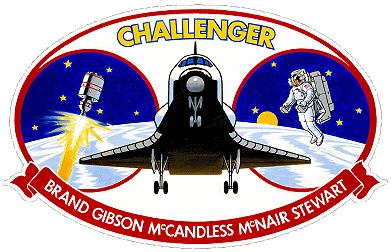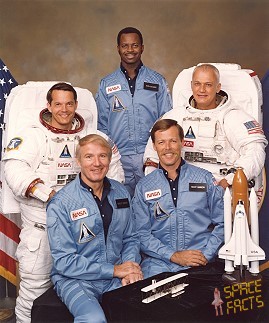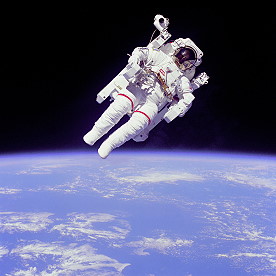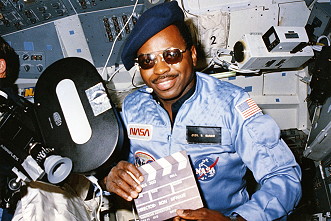Human Orbital Spaceflights
![]()
International Flight No. 92STS-41BChallenger (4)10th Space Shuttle missionUSA |
 |
 |
 |
 |
|
 |
||
![]()
Launch, orbit and landing data
walkout photo |
 |
||||||||||||||||||||||||||||
alternative crew photo |
Crew
| No. | Surname | Given names | Position | Flight No. | Duration | Orbits | |
| 1 | Brand | Vance DeVoe | CDR | 3 | 7d 23h 15m 55s | 128 | |
| 2 | Gibson | Robert Lee "Hoot" | PLT | 1 | 7d 23h 15m 55s | 128 | |
| 3 | McNair | Ronald Erwin | MS-1, RMS | 1 | 7d 23h 15m 55s | 128 | |
| 4 | Stewart | Robert Lee | MS-2, EV-2, FE | 1 | 7d 23h 15m 55s | 128 | |
| 5 | McCandless | Bruce II | MS-3, EV-1 | 1 | 7d 23h 15m 55s | 128 |
Crew seating arrangement
|
 |
|
||||||||||||||||||||||||
Hardware
| Orbiter : | OV-099 (4.) |
| SSME (1 / 2 / 3): | 2109 (1.) / 2015 (4.) / 2012 (4.) |
| SRB: | A57/58 |
| ET: | ET-10 (LWT-3) |
| OMS Pod: | Left Pod 01 (4.) / Right Pod 01 (4.) |
| FWD RCS Pod: | FRC 9 (4.) |
| RMS: | 201 (6.) |
| EMU: | EMU No. 1040 (PLSS No. 1008) / EMU No. 1038 (PLSS No. 1009) EMU No. 1041 (PLSS No. 1007) |
Flight
|
Launch from Cape Canaveral (KSC) and
landing in Cape Canaveral (KSC), Runway 15. Following STS-9, the flight numbering system for the Space Shuttle program was changed. Thus, the next flight, instead of being designated STS-11, became STS-41B; the original successor to STS-9, STS-10, was cancelled due to payload delays. The primary goal on the eight-day mission was to deploy into orbit two commercial communications satellites - Western Union's Westar VI and the Indonesian Palapa B2. Furthermore, NASA astronauts were scheduled to perform the first untethered space walks to demonstrate spacewalk techniques important for the successful retrieval and repair of the disabled Solar Maximum spacecraft. STS-41B also should see the reflight of the West German-sponsored SPAS-1 pallet/satellite, which had originally flown on STS-7. The deployment of the communications satellite Westar-VI (USA) and Palapa B2 (Indonesia) occurred on flight day 1 respectively on flight day 3. Both satellites did reach only a radical low Earth orbit because of a Payload Assist Module-D (PAM-D) malfunction. Both satellites were retrieved successfully during the mission STS-51A. Westar VI was planned to be the third advanced Western Union communications satellite in orbit and the first Westar satellite to be launched from the Space Shuttle. Previous Westars were launched aboard the NASA Delta launch vehicle. The current four-satellite Westar system provides continuous video, facsimile, data and voice communications service throughout the continental United States, Alaska, Hawaii, Puerto Rico and the Virgin Islands. Westar VI had 24 transponders and six backup transponders. Each transponder was capable of handling 2,400 one-way voice circuits or a color TV transmission. This particular satellite was committed to business communications. A McDonnell Douglas Payload Assist Module (PAM) was scheduled to boost the satellite into its geosynchronous transfer orbit. However, the PAM malfunctioned and the satellite was stranded in low orbit. Palapa B2, the Indonesian national telecommunications satellite, was the second Palapa to be placed into orbit by the orbiter Challenger; the first was during the STS-7 mission. Palapa B2 provided 24 additional transponders to the communications network that provides service to the island nation of Indonesia and also to ASEAN (the Association of Southeast Asia Nations) which included the Philippines, Thailand, Malaysia, Singapore and Papua, New Guinea. The spacecraft (with antennas deployed) was 6.8 m (22.4 ft.) high and 2.16 m (7 ft.) in diameter. Liftoff weight (with perigee stage) was 4,366 kg (9,625 lb.). A McDonnell Douglas Payload Assist Module (PAM) was scheduled to place the satellite into geosynchronous orbit. The PAM deployment included spinup of the payload to 50 rpm, a spring assisted kick out of the cargo bay and solid rocket motor ignition on the spacecraft at deploy plus 45 minutes. However, the PAM malfunctioned and the satellite was stranded in low orbit. The Shuttle Pallet Satellite (SPAS-01A) was flown for the second time in space, but remained in the attached mode during this mission. The SPAS-01A had a mass of 1,448 kg (3,192 lb.). It measures 4.8 m (15.7 ft.) across, 3.4 m (11 ft.) high and 1.5 m (4.9 ft.) wide. The West German-built platform will carry the same set of experiments that were aboard during STS-7. Bruce McCandless and Robert Stewart tested in two EVAs on February 07, 1984 (5h 55m) and February 09, 1984 (6h 17m) the "Manned Maneuvering Unit" (MMU). The first MMU EVA began on mission day 5 of STS-41B. For the EVA Vance Brand provided intravehicular support during suit-up, monitored MMU speed and distance using Challenger's radar, and flew the orbiter, while Ronald McNair operated the Remote Manipulator System (RMS) mechanical arm. Jerry Ross was EVA CapCom in Houston for this and all subsequent MMU EVAs. In addition to testing the MMU in flight, Bruce McCandless and fellow MMU flyer Robert Stewart performed a dress rehearsal for the Solar Maximum Mission (Solar Max) satellite retrieval, scheduled for the next flight (STS-41C). Both flight MMUs were carried in the forward part of Challenger's payload bay. To help relieve the thrashing and banging which occurred during airlock depressurization on STS-6, Bruce McCandless pointed his head toward the airlock floor while Robert Stewart pointed toward the ceiling. Bruce McCandless spent 90 minutes checking and donning the port MMU, then tested it in the payload bay by maneuvering precisely around equipment. He found that the backpack shuddered and shook when forward movement was initiated in attitude hold. Bruce McCandless then moved 45 m (150 ft) out from Challenger, returned to the payload bay, flew out to 96 m (315 ft) and returned, then moved out again to about 99 m (325 ft). MMU nitrogen propellant use was higher than in simulations. Brand noted that the MMU's tracking lights were inadequate for finding the astronaut if he strayed away during orbital night, so ordered Bruce McCandless to hurry back to the payload bay before Challenger passed into darkness. Meanwhile, Robert Stewart installed a Manipulator Foot Restraint (MFR) on the RMS, but had to postpone a test ride because the EVA was behind schedule. When Bruce McCandless returned to the payload bay, Robert Stewart attached between the MMU arms the Trunnion Pin Attachment Device (TPAD) to be used to snare Solar Max. Bruce McCandless practiced docking with a trunnion pin mounted next to a mockup of the Solar Max main electronics box in the payload bay. Bruce McCandless reported later that he was chilled when out away from the payload bay. Robert Stewart then flew the MMU 93 m (306 ft) from Challenger. Vance Brand noted that Robert Stewart was traveling at 0.6 mps (2 fps) about 90 m (300 ft) from Challenger, so warned him to slow down. Robert Stewart tested the MMU for 65 minutes. Meanwhile, Bruce McCandless became the first astronaut to ride the MFR at end of RMS. The arm proved more stable for EVA work than expected. On mission day 7 Robert Stewart and Bruce McCandless ventured outside again, this time with Robert Gibson operating the RMS. The manipulator arm suffered wrist joint and elbow TV camera malfunctions prior to this EVA. The camera problem meant that engineering film coverage of the EVA was not as comprehensive as planned. The joint failure was much more serious - it meant that the RMS could not release a rotating Shuttle Pallet Satellite above Challenger's payload bay, depriving the MMU astronauts of a spinning target for practice docking using the TPAD. The ability to dock with a rotating target was considered crucial to the Solar Max repair scheduled for STS-41C. The astronauts practiced docking with fixed targets instead. Robert Stewart performed a hydrazine transfer experiment to help validate the orbiter's proposed role as a satellite tanker. Freon dyed red for visibility filled in for poisonous hydrazine. A foot restraint worked itself loose; Vance Brand maneuvered Challenger and Bruce McCandless moved down the starboard sill to retrieve the errant hardware. NASA called this an unplanned test of the Shuttle's ability to rescue an astronaut stranded by MMU failure. Resembling its ancestor flown inside the Skylab orbital Workshop in the early 1970s, the Manned Maneuvering Unit (MMU) is a self-contained backpack with nitrogen gas propulsion that will allow orbiter crews to move outside the payload bay to other parts of the orbiter or to another spacecraft. The MMU latches to the spacesuit (Extravehicular Mobility Unit-EMU) backpack and can be donned and doffed by an astronaut unassisted. MMU controls follow the layout familiar to spacecraft crews: the left-hand controller governs fore-aft, right-left, up-down translations, while the right-hand controller handles roll, pitch and yaw motions. The controllers may be used singly or in combination to give a full range of movement within the operating logic of 729 command combinations, including attitude hold. Thrust impulses are from 24 dry nitrogen gas thrusters each with 7.56 Newtons thrust. Two 25-by-76-centimeter (9.8-by-30 inch) Kevlar filament-wrapped aluminum nitrogen tanks each hold 5.9 kilograms (13 pounds) of nitrogen when fully charged. Two 16.8-volt, 752 watt-hour silver zinc batteries supply MMU electrical power, enough for one six-hour EVA. The nitrogen tanks may be recharged in less than 20 minutes at the payload bay MMU service rack. The deploying of the "balloon satellite" IRT (Integrated Rendezvous Target) failed due to internal failure. IRT was scheduled as a forerunner to the Solar Maximum Repair Mission (STS-41C), the rendezvous, capture and on-orbit repair of the SMM satellite. The Integrated Rendezvous Target (IRT) was a 2 m (6.4 foot) diameter balloon that should be deployed from a rack bolted to the forward end of the Challenger's longeron on the port side of the payload bay. The target and its canister were ejected from the Challenger in a retrograde direction at 1.5 feet per second. One minute after ejection from the payload bay the canister was scheduled split in half and inflate automatically with nitrogen to a pressure of .3 psia. Built of one-mil thick aluminized Mylar, the IRT balloon was flat white in color except for one of the 24 gores painted infrared black. The balloon, inflation equipment and sintered tungsten ballast results in a total weight of 90.7 kg (200 lb.). Experiments in Earth sciences, space technologies and navigation were performed. The Monodisperse Latex Reactor (MLR) has been carried on four previous Shuttle flights. The materials processing experiment is designed to develop identical-sized (monodisperse) latex particles. The particles may have major medical and industrial research applications. The reactor was mounted in a locker in the orbiter crew compartment. It consisted of four 3-m (l-ft.) high reactors, each containing a chemical latex-forming recipe, housed in a .6-m (2-ft.) high metal cylinder. The Acoustic Containerless Experiment System (ACES) was a materials processing furnace experiment enclosed in two airtight canisters in the orbiter middeck. Activated at 23 hours mission elapsed time, the ACES ran a preprogrammed sequence of operations and shut itself off after two hours. The IsoElectric Focusing (IEF) experiment was another self-contained experiment package in the middeck lockers and activated by the crew at the same time the ACES is turned on. IEF evaluates the effect of electro-osmosis on an array of eight columns of electrolyte solutions as DC power is applied and pH levels between anodes and cathodes increase. Two Cinema 360 cameras were carried aboard the Challenger to provide a test for motion picture photography in a unique format designed especially for planetarium viewing. One camera was located in the crew cabin area and the other in a GAS canister in the payload bay. The primary objective was to test the equipment and concept. Arriflex 35 mm Type 3 motion picture cameras with an 8 mm/f2.8 "fisheye" lens were used. The Cinema 360 camera, including an accessory handle and lens guard/support, weighs approximately 9.5 kg (21 lb.). A system power supply weighs an additional 7.7 kg (17 lb.). The mission also carried five GAS canisters, six live rats in the middeck area. For this flight, three rats were injected with complete Freund's adjuvant, which causes symptoms similar to rheumatoid arthritis in humans. This technique is used by pharmaceutical companies to study arthritis and arthritic medications. The other three rats will be flown as normal controls. Six additional animals were kept at Kennedy Space Center as further controls for the experiment. Included in one of the Get Away Special canisters was the first experiment by a high school team to fly in space. The experiment, on seed germination and growth in zero gravity, was created and built by a team from Brighton High School in Utah through a partnership with Utah State University. Challenger made the first landing in Cape Canaveral (KSC). |
EVA data
| Name | Start | End | Duration | Mission | Airlock | Suit | |
| EVA | McCandless, Bruce | 07.02.1984, 12:10 UTC | 07.02.1984, 18:05 UTC | 5h 55m | STS-41B | Challenger | EMU No. 1040 |
| EVA | Stewart, Robert | 07.02.1984, 12:10 UTC | 07.02.1984, 18:05 UTC | 5h 55m | STS-41B | Challenger | EMU No. 1038 |
| EVA | McCandless, Bruce | 09.02.1984, 10:24 UTC | 09.02.1984, 16:41 UTC | 6h 17m | STS-41B | Challenger | EMU No. 1040 |
| EVA | Stewart, Robert | 09.02.1984, 10:24 UTC | 09.02.1984, 16:41 UTC | 6h 17m | STS-41B | Challenger | EMU No. 1038 |
Photos / Graphics
 |
 |
 |
 |
|
photo courtesy J.L. Pickering |
|
 |
 |
 |
 |
 |
 |
 |
 |
 |
 |
 |
 |
 |
 |
 |
 |
 |
 |
more EVA photos |
|
| © |  |
Last update on January 21, 2023.  |
 |